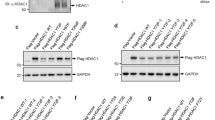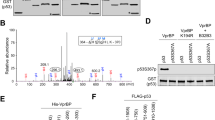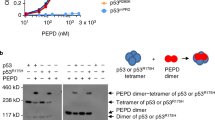Abstract
We have previously demonstrated that the serine/threonine protein phosphatase-1 (PP-1) plays an important role in promoting cell survival. However, the molecular mechanisms by which PP-1 promotes survival remain largely unknown. In the present study, we provide evidence to show that PP-1 can directly dephosphorylate a master regulator of apoptosis, p53, to negatively modulate its transcriptional and apoptotic activities, and thus to promote cell survival. As a transcriptional factor, the function of p53 can be greatly regulated by phosphorylation and dephosphorylation. While the kinases responsible for phosphorylation of the 17 serine/threonine sites have been identified, the dephosphorylation of these sites remains largely unknown. In the present study, we demonstrate that PP-1 can dephosphorylate p53 at Ser-15 and Ser-37 through co-immunoprecipitation, in vitro and in vivo dephosphorylation assays, overexpression and silence of the gene encoding the catalytic subunit for PP-1. We further show that mutations mimicking constitutive dephosphorylation or phosphorylation of p53 at these sites attenuate or enhance its transcriptional activity, respectively. As a result of the changed p53 activity, expression of the downstream apoptosis-related genes such as bcl-2 and bax is accordingly altered and the apoptotic events are either largely abrogated or enhanced. Thus, our results demonstrate that PP-1 directly dephosphorylates p53, and dephosphorylation of p53 has as important impact on its functions as phosphorylation does. In addition, our results reveal that one of the molecular mechanisms by which PP-1 promotes cell survival is to dephosphorylate p53, and thus negatively regulate p53-dependent death pathway.
This is a preview of subscription content, access via your institution
Access options
Subscribe to this journal
Receive 50 print issues and online access
$259.00 per year
only $5.18 per issue
Buy this article
- Purchase on Springer Link
- Instant access to full article PDF
Prices may be subject to local taxes which are calculated during checkout











Similar content being viewed by others
Abbreviations
- CAT:
-
chloramphenicol acetyltransferase
- DMEM:
-
Dulbecco's Eagle's modified minimal essential medium
- PMSF:
-
phenylmethylsulfonyl fluoride
- HLECs:
-
human lens epithelial cells
- MLECs:
-
mouse lens epithelial cells
- PP-1:
-
protein serine/threonine phosphatase-1
- PP-1cas:
-
the catalytic subunit of PP-1
- SDS–PAGE:
-
SDS–polyacrylamide gel electrophoresis
- TBS:
-
tris-buffered saline
- TBST:
-
tris-buffered saline with tween-20
References
Ashcroft M, Taya Y, Vousden KH . (2000). Mol Cell Biol 20: 3224–3233.
Ayllon V, Martinez AC, Garcia A, Cayla X, Rebollo A . (2000). EMBO J 19: 2237–2246.
Bakkenist CJ, Kastan MB . (2003). Nature 421: 499–506.
Banin S, Moyal L, Shieh S, Taya Y, Anderson CW, Chessa L et al. (1998). Science 281: 1674–1677.
Bargonetti J, Manfredi JJ . (2002). Curr Opin Oncol 14: 86–91.
Bargonetti J, Reynisdottir I, Friedman PN, Prives C . (1992). Genes Dev 6: 1886–1898.
Bastians H, Ponstingl H . (1994). J Cell Sci 109: 2865–2874.
Bech-Otschir D, Kraft R, Huang X, Henklein P, Kapelari B, Pollmann C et al. (2001). EMBO J 20: 1630–1639.
Blaydes JP, Luciani MG, Pospisilova S, Ball HM, Vojtesek B, Hupp TR . (2001). J Biol Chem 276: 4699–4708.
Bode AM, Dong ZG . (2004). Nat Rev Cancer 4: 793–805.
Boe R, Gjertsen BT, Vintermyr OK, Houge G, Lanotte M, Doskeland SO . (1991). Exp Cell Res 195: 237–246.
Brewis ND, Street AJ, Prescott AR, Cohen PTW . (1993). EMBO J 12: 987–996.
Buckbinder L, Talbott R, Velasco-Miguel S, Takenaka I, Faha B, Seizinger BR et al. (1995). Nature 377: 646–649.
Bulavin DV, Saito S, Hollander MC, Sakaguchi K, Anderson CW, Appella E et al. (1999). EMBO J 18: 6845–6854.
Buschmann T, Adler V, Matusevich E, Fuchs SY, Ronai Z . (2000). Cancer Res 60: 896–900.
Buschmann T, Potapova O, Bar-Shira A, Ivanov VN, Fuchs SY, Henderson S et al. (2001). Mol Cell Biol 21: 2743–2754.
Chao C, Saito S, Anderson CW, Appella E, Xu Y . (2000). Proc Natl Acad Sci USA 97: 11936–11941.
Chehab NH, Malikzay A, Appel M, Halazonetis TD . (2000). Genes Dev 14: 278–288.
Chehab NH, Malikzay A, Stavridi ES, Halazonetis TD . (1999). Proc Natl Acad Sci USA 96: 13777–13782.
Chen MX, McPartlin AE, Brown L, Chen YH, Baker HM, Cohen PTW . (1994). EMBO J 12: 4278–4290.
Chernov MV, Bean LJ, Lerner N, Stark GR . (2001). J Biol Chem 276: 31819–31824.
Chiesa R, Spector A . (1989). Biochem Biophys Res Commun 162: 1494–1501.
Chinkers M . (1994). Proc Natl Acad Sci USA 91: 11075–11079.
Cohen P . (1989). Annu Rev Biochem 58: 453–508.
Cuddihy AR, Wong AH, Tam NW, Li S, Koromilas AE . (1999). Oncogene 18: 2690–2702.
DePaoli-Roach AA . (2003) In: Bradshaw RA, Dennis EA (eds). Handbook of Cell Signaling, vol. 1. Elsevier Science Press: San Diego, CA, USA, pp 613–619 (Chapter 103).
Dohoney KM, Guillerm C, Whiteford C, Elbi C, Lambert PF, Hager GL et al. (2004). Oncogene 23: 49–57.
Donehower LA, Harvey M, Slagle BL, McArthur MJ, Montgomery Jr CA, Butel J et al. (1992). Nature (London) 356: 215–221.
Dumaz N, Milne DM, Meek DW . (1999). FEBS Lett 463: 312–316.
El-Deiry WS . (1998). Semin Cancer Biol 8: 345–357.
Feng H, Xiang H, Mao Y-W, Wang J, Liu J-P, Huang X-Q et al. (2004). Oncogene 23: 7310–7321.
Fernandez-Sanchez M, Garcia-Rodriguez A, Diaz-Trelles R, Novelli A . (1996). FEBS Lett 398: 106–112.
Fiscella M, Zhang H, Fan S, Sakaguchi K, Shen S, Mercer WE et al. (1997). Proc Natl Acad Sci USA 94: 6048–6053.
Franklin RA, McCubrey JA . (2000) 14: 2019–2034.
Fuchs SY, Adler V, Buschmann T, Yin Z, Wu X, Jones SN et al. (1998a). Genes Dev 12: 2658–2663.
Fuchs SY, Adler V, Pincus MR, Ronai Z . (1998b). Proc Natl Acad Sci USA 95: 10541–10546.
Garcia A, Cayla X, Guergnon J, Dessauge F, Hospital V, Rebollo MP et al. (2003). Biochimie 85: 721–726.
Gatti A, Li HH, Traugh JA, Liu X . (2000). Biochemistry 39: 9837–9842.
Giaccia A, Kastan MB . (1998). Genes Dev 12: 2973–2983.
Gjertsen BT, Doskeland SO . (1995). Biochim Biophys Acta 1269: 187–199.
Gossen M, Freundlieb S, Bender G, Muller G, Hillen W, Bujard H . (1995). Science 268: 1766–1769.
Hahn WC, Dessain SK, Brooks MW, King JE, Elenbaas B, Sabatini DM et al. (2002). Mol Cell Biol 22: 2111–2123.
Haneda M, Kojima E, Nishikimi A, Hasegawa T, Nakashima I, Isobe K . (2004). FEBS Lett 567: 171–174.
Haupt Y, Maya R, Kazaz A, Oren M . (1999). Nature 387: 296–299.
Higashimoto Y, Saito S, Tong XH, Hong A, Sakaguchi K, Appella E et al. (2000). J Biol Chem 275: 23199–23203.
Hirao A, Kong YY, Matsuoka S, Wakeham A, Ruland J, Yoshida H et al. (2000). Science 287: 1824–1827.
Hofmann TG, Moller A, Sirma H, Zentgraf H, Taya Y, Droge W et al. (2002). Nat Cell Biol 4: 1–10.
Honda R, Yasuda H . (1999). EMBO J 18: 22–27.
Huang C, Ma WY, Maxiner A, Sun Y, Dong Z . (1999). J Biol Chem 274: 12229–12235.
Huang X, Honkananen RE . (1998). J Biol Chem 273: 1462–1468.
Hunter T, Karin M . (1992). Cell 70: 375–387.
Hupp TR, Meek DW, Midgley CA, Lane DP . (1992). Cell 71: 875–886.
Ishida Y, Furukawa Y, De Caprio JA, Saito M, Griffin JD . (1992). J Cell Physiol 150: 484–492.
Ishihara H, Martin BL, Brautigan DL, Karaki H, Ozaki H, Kato Y et al. (1989). Biochem Biophys Res Commun 159: 871–877.
Israeli D, Tessler E, Haupt Y, Elkeles A, Wilder S, Amson R et al. (1997). EMBO J 16: 4384–4392.
Kaeser MD, Pebernard S, Iggo RD . (2004). J Biol Chem 279: 7598–7605.
Kaighn ME, Narayan KS, Ohnuki Y, Lechner JF, Jones LW . (1979). Invest Urol 17: 16–23.
Katayama H, Sasai K, Kawai H, Yuan ZM, Bondaruk J, Suzuki F et al. (2004). Nat Genet 36: 55–62.
Keller DM, Zeng X, Wang Y, Zhang QH, Kapoor M, Shu H et al. (2001). Mol Cell 7: 283–292.
Khanna KK, Keating KE, Kozlov S, Scott S, Gatei M, Hobson K et al. (1998). Nat Genet 20: 398–400.
Kiguchi K, Glesne D, Chubb CH, Fujiki H, Huberman E . (1994). Cell Growth Differ 5: 995–1004.
Klumpp S, Krieglstein J . (2002). Curr Opin Pharmacol 2: 458–462.
Knippschild U, Milne DM, Campbell LE, DeMaggio AJ, Christenson E, Hoekstra MF et al. (1997). Oncogene 15: 1727–1736.
Kubbutat MH, Jones SN, Vousden KH . (1997). Nature 387: 299–303.
Lassus P, Rodriguez J, Lazebnik Y . (2002). Sci STKE 147: PL13.
Lees-Miller SP, Sakaguchi K, Ullrich SJ, Appella E, Anderson CW . (1992). Mol Cell Biol 12: 5041–5049.
Li HH, Li AG, Sheppard HM, Liu X . (2004a). Mol Cell 13: 867–878.
Li L, Ljungman M, Dixon JE . (2000). J Biol Chem 275: 2410–2414.
Li DW-C, Fass U, Huizar I, Spector A . (1998). Eur J Biochem 257: 351–361.
Li W-C, Kuszak JR, Dunn K, Wang RR, Ma W, Wang GM et al. (1995). J Cell Biol 130: 169–181.
Li DW-C, Liu J-P, Wang J, Mao Y-W, Hou L-H . (2003). Invest Ophthalmol Vis Sci 44: 5277–5286.
Li DW-C, Liu J-P, Schmid PC, Schlosser R, Feng H . (2004b). Invest Ophthalmol Vis Sci 45 (Suppl): E401 (abstract).
Li DW-C, Liu J-P, Xiang H, Mao YW, Wang J, Ma WY et al. (2005). Mol Cell Biol 16: 4437–4453.
Li W-C, Spector A . (1996). Free Radic Biol Med 20: 301–311.
Li DW-C, Xiang H, Fass U, Zhang X-Y . (2001b). Invest Ophthalmol Vis Sci 42: 2603–2609.
Li DW-C, Xiang H, Mao YW, Wang J, Fass U, Zhang XY et al. (2001a). Exp Cell Res 266: 279–291.
Llanos S, Clark PA, Rowe J, Peters G . (2001). Nat Cell Biol 3: 445–452.
Long X, Wu G, Gaa ST, Rogers TB . (2002). Apoptosis 7: 31–39.
Lu H, Fisher RP, Bailey P, Levine AJ . (1997). Mol Cell Biol 17: 5923–5934.
Ludlow JW, Glendening CL, Livingston DM, De Caprio JA . (1993). Mol Cell Biol 13: 367–372.
Manfredi JJ . (2003). Mol Cell 11: 552–554.
Mao YW, Liu J-P, Xiang H, Li DW . (2004). Cell Death Differ 11: 512–526.
Mao YW, Xiang H, Wang J, Korsmeyer S, Reddan J, Li DW . (2001). J Biol Chem 276: 43435–43445.
Meek DW . (1998). Cell Signal 10: 159–166.
Mellgren G, Vintermyr OK, Boe R, Doskeland SO . (1993). Exp Cell Res 205: 293–301.
Mietz JA, Unger T, Huibregtse JM, Howley PM . (1992). EMBO J 11: 5013–5020.
Mihara M, Erster S, Zaika A, Petrenko O, Chittenden T, Pancoska P et al. (2003). Mol Cell 11: 577–590.
Miyashita T, Krajewski S, Krajewska M, Wang HG, Lin HK, Liebermann DA et al. (1994). Oncogene 9: 1799–1805.
Miyashita T, Reed JC . (1995). Cell 80: 293–299.
Momand J, Zambetti GP, Olson DC, George D, Levine AJ . (1992). Cell 69: 1237–1245.
Morana SJ, Wolf CM, Li J, Reynolds JE, Brown MK, Eastman A . (1996). J Biol Chem 271: 18263–18271.
Mumby MC, Walter G . (1993). Physiol Rev 73: 673–699.
Nakagawa K, Taya Y, Tamai K, Yamaizumi M . (1999). Mol Cell Biol 19: 2828–2834.
Nevins JR . (1992). Science 258: 424–429.
Oren M . (2003). Cell Death Differ 10: 431–442.
Park I, Roach P, Bondor J, Fox SP, DePaoli-Roach AA . (1994). J Biol Chem 269: 944–954.
Pawson T . (1995). Nature 373: 573–579.
Polyak K, Xia Y, Zweier JL, Kinzler KW, Vogelstein B . (1997). Nature 389: 300–305.
Pomerantz J, Schreiber-Agus N, Liegeois NJ, Silverman A, Alland L, Chin L et al. (1998). Cell 92: 713–723.
Qu L, Huang S, Baltzis D, Rivas-Estilla AM, Pluquet O, Hatzoglou M et al. (2004). Genes Dev 18: 261–277.
Sakaguchi K, Saito S, Higashimoto Y, Roy S, Anderson CW, Appella E . (2000). J Biol Chem 275: 9278–9283.
Saito S, Goodarzi AA, Higashimoto Y, Noda Y, Lees-Miller SP, Appella E et al. (2002). J Biol Chem 277: 12491–12494.
Scacheri PC, Rozenblatt-Rosen O, Caplen NJ, Wolfsberg TG, Umayam L, Lee JC et al. (2004). Proc Natl Acad Sci USA 101: 1892–1897.
Scheidtmann KH, Mumby MC, Rundell K, Walter G . (1991). Mol Cell Biol 11: 1996–2003.
Schular M, Green DR . (2005). Trends Genet 21: 182–187.
She QB, Chen N, Dong Z . (2000). J Biol Chem 275: 20444–20449.
She QB, Ma WY, Dong Z . (2002). Oncogene 21: 1580–1589.
Sheikh MS, Garcia M, Zhan Q, Liu Y, Fornace Jr AJ . (1996). Cell Growth Differ 7: 1599–1607.
Shen Y, White E . (2001). Adv Cancer Res 82: 55–84.
Shieh SY, Ahn J, Tamai K, Taya Y, Prives C . (2000). Genes Dev 14: 289–300.
Shieh SY, Ikeda M, Taya Y, Prives C . (1997). Cell 91: 325–334.
Siliciano JD, Canman CE, Taya Y, Sakaguchi K, Appella E, Kastan MB . (1997). Genes Dev 11: 3471–3481.
Stott FJ, Bates S, James MC, McConnell BB, StaRborg M, Brookes S et al. (1998). EMBO J 17: 5001–5014.
Takenaka I, Morin F, Seizinger BR, Kley N . (1995). J Biol Chem 270: 5405–5411.
Tibbetts RS, Brumbaugh KM, Williams JM, Sarkaria JN, Cliby WA, Shieh SY et al. (1999). Genes Dev 13: 152–157.
Trimarchi JM, Lees JA . (2002). Nat Rev Mol Cell Biol 3: 11–20.
Unger T, Juven-Gershon T, Moallem E, Berger M, Vogt Sionov R, Lozano G et al. (1999). EMBO J 18: 1805–1814.
Vousden KH, Lu X . (2002). Nat Rev Cancer 2: 594–604.
Walter G . (2003) In: Bradshaw RA, Dennis EA (eds). Handbook of Cell Signaling, vol. 1. Elsevier Science Press: San Diego, CA, USA, pp 621–626 (Chapter 104).
Weber JD, Taylor LJ, Roussel MF, Sherr CJ, Bar-Sagi D . (1999). Nat Cell Biol 1: 20–26.
Weller M, Malipiero U, Groscurth P, Fontana A . (1995). Exp Cell Res 221: 395–403.
Wen-Schaub LB, Zhang W, Cusack JC, Angelo LS, Santee SM, Fujiwara T et al. (1995). Mol Cell Biol 15: 3032–3040.
Weinberg RA . (1995). Cell 81: 323–330.
Wu GS, Burns TF, McDonald III ER, Jiang W, Meng R, Krantz ID et al. (1997). Nat Genet 17: 141–143.
Xiang H, Wang J, Mao Y, Li DW . (2000). Biochem Biophys Res Commun 278: 503–510.
Xiang H, Wang J, Mao Y, Liu M, Reddy VN, Li DW . (2002). Oncogene 21: 3784–3791.
Yan Y, Shay JW, Wright WE, Mumby MC . (1997). J Biol Chem 272: 15220–15226.
Yeh PY, Chuang SE, Yeh KH, Song YC, Cheng AL . (2001). Biochem Biophys Res Commun 284: 880–886.
Yu J, Boyapati A, Rundell K . (2001). Virology 290: 192–198.
Zhang Y, Xiong Y, YaRbrough WG . (1998). Cell 92: 725–734.
Zhu JW, DeRyckere D, Li FX, Wan YY, DeGregori J . (1999). Cell Growth Differ 10: 829–838.
Zindy F, Williams RT, Baudino TA, Rehg JE, Skapek SX, Cleveland JL et al. (2003). Proc Natl Acad Sci 100: 15930–15935.
Zuo Z, Dean NM, Honkanen RE . (1998). J Biol Chem 273: 12250–12258.
Acknowledgements
We thank Dr John Reed for the pCMV-p53 and pBax-CAT expression constructs; Joram Piatigorsky for pRSV-β-galactosidase expression construct; Dr Venkat Reddy for HLE cell line. This work is supported in part by the NIH/NEI grant EY15765, the Hormel Foundation and the Lotus Scholar Program Funds from Hunan Province Government and Hunan Normal University.
Author information
Authors and Affiliations
Corresponding author
Rights and permissions
About this article
Cite this article
Li, DC., Liu, JP., Schmid, P. et al. Protein serine/threonine phosphatase-1 dephosphorylates p53 at Ser-15 and Ser-37 to modulate its transcriptional and apoptotic activities. Oncogene 25, 3006–3022 (2006). https://doi.org/10.1038/sj.onc.1209334
Received:
Revised:
Accepted:
Published:
Issue Date:
DOI: https://doi.org/10.1038/sj.onc.1209334
Keywords
This article is cited by
-
Protein post-translational modifications in the regulation of cancer hallmarks
Cancer Gene Therapy (2023)
-
The roles of miR-200c in colon cancer and associated molecular mechanisms
Tumor Biology (2014)
-
Dynamics of p53 and NF-κB regulation in response to DNA damage and identification of target proteins suitable for therapeutic intervention
BMC Systems Biology (2012)
-
Angiogenin functionally interacts with p53 and regulates p53-mediated apoptosis and cell survival
Oncogene (2012)
-
The viral tropism of two distinct oncolytic viruses, reovirus and myxoma virus, is modulated by cellular tumor suppressor gene status
Oncogene (2010)



